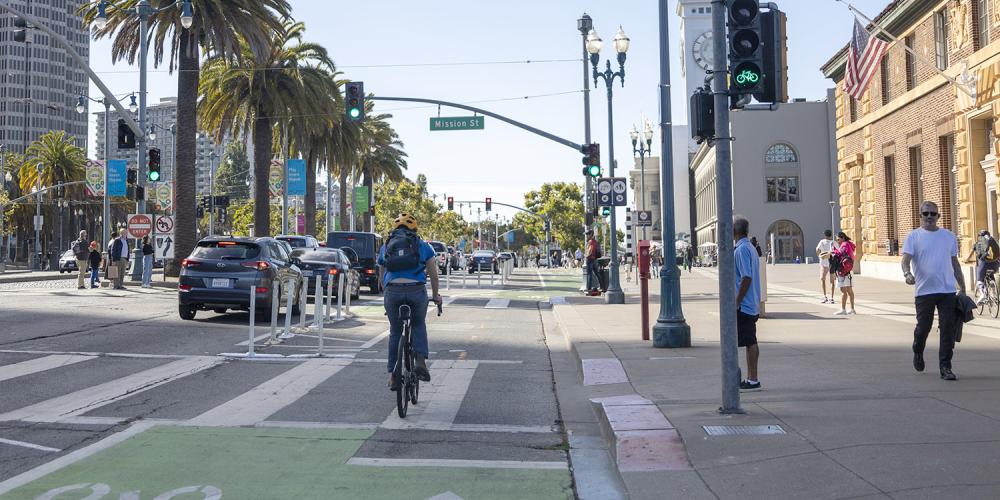
Why Consider a Bicycle and Pedestrian Infrastructure Action Plan (BPIAP)?
Key reasons for developing a BPIAP include:
- Providing a roadmap for implementation of a set of near-term bicycle and pedestrian improvements that align with a jurisdiction’s longer-term safety and mobility goals.
- Supporting the integration of bicycle and pedestrian improvements into jurisdiction-wide infrastructure planning processes.
- Increasing opportunities to access funding for roadway and bicycle and pedestrian facilities, such as funding through the Active Transportation Program (ATP), One Bay Area Grant (OBAG), Highway Safety Improvement Program (HSIP) Grant, the California Active Transportation Program Safe Streets for All (SS4A) Grant, among others.
- Supporting the jurisdiction’s designation as a Connected Community Priority Development Area (PDA) and access to related MTC funding opportunities, if adopted in concert with a Local Road Safety Plan (LRSP) or Vision Zero Action Plan (VZAP).
What is a Bicycle and Pedestrian Infrastructure Action Plan (BPIAP)?
A BPIAP provides a set of near-term improvements that align with a jurisdiction’s longer-term adopted transportation plans. The Action Plan should focus on a one to five year implementation timeframe or quick-build infrastructure improvements for people using active transportation modes and identify the timeline and path forward to bring high-priority projects to construction or implementation. Bicycle improvements should focus on Class I, Class II or Class IV facilities that provide dedicated bicycle infrastructure. Plans should also include and emphasize actions that incorporate bicycle and pedestrian safety into infrastructure planning processes, including pedestrian signal timing adjustment, integration of striping that increases bicycle/pedestrian safety into paving contracts, and the establishment of new high-visibility crosswalk standards.
Core elements of a BPIAP include, but are not limited to:
- Project selection based on objective criteria, including collision data collected in previous plans
- Design guidelines that adhere to best practice recommendations for on- and off-street facilities established in national, state and/or regional resources such as NACTO, FHWA, AASHTO and the Bay Trail Design Guidelines
- Project cost estimates
- Identification of funding sources and timelines for implementation
Jurisdictions with a Connected Community PDA may use a BPIAP, coupled with a LRSP or VZAP, to satisfy MTC’s Vehicle Miles Traveled (VMT) reduction-planning requirements for Connected Community PDAs. The BPIAP builds off the LSAP/VZAP to provide a specific roadmap for implementation of near-term actions to address local safety and mobility issues for people walking and rolling.
What Kinds of Communities Should Consider Developing a BPIAP?
- Communities seeking to rapidly implement bicycle and pedestrian projects and strategies designed to improve safety, encourage the use of active transportation and reduce VMT
- Communities that have an existing Local Road Safety Plan or Vision Zero Action Plan that can be leveraged to develop a concise list of near-term projects and strategies
Key Planning Steps
The steps to develop a bicycle/pedestrian action plan are listed below. Refer to the BPIAP Policy Development Guide for more detailed guidance.
- Establish leadership
- Identify a champion
- Identify and contact stakeholders
- Coordinate program
- Gain leadership support
- Solicit consultant services if desired
- Develop and release an RFP (BPIAP Request for Proposals Template)
- Review proposals and select a consultant
- Finalize the contract
- Develop the plan
- Develop an engagement plan
- Collect data and/or facilitate access to data sources
- Identify projects for inclusion in the BPIAP and estimate project costs (BPIAP Project Selection Worksheet)
- Develop or adopt existing design guidelines based on national, state and/or regional best practice recommendations (BPIAP Implementation Program Guidance)
- Identify funding sources, timelines for implementation and status reporting plan (BPIAP Implementation Program Guidance)
- Develop the plan document
- Implement the plan
- Draft staff reports to support council action (BPIAP Staff Report Guidance)
- Draft and/or request presentations to support community engagement and council action (BPIAP Presentations Worksheet)
Sample Documents
In addition to the guidance linked in the key planning steps above, the following sample documents are provided:

